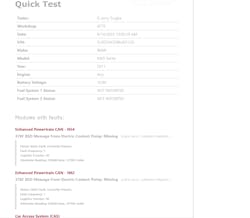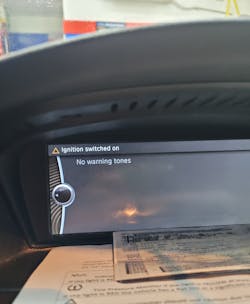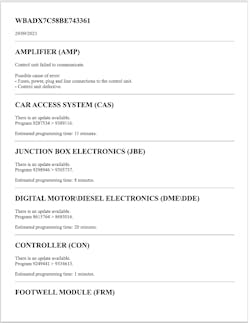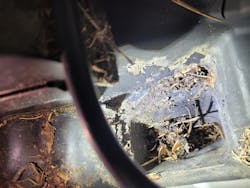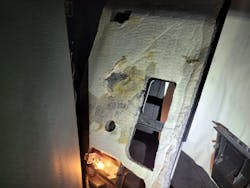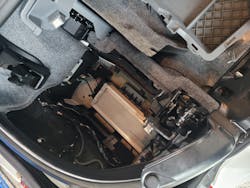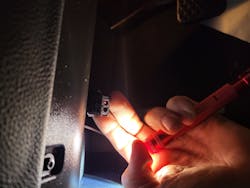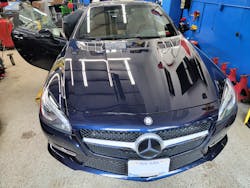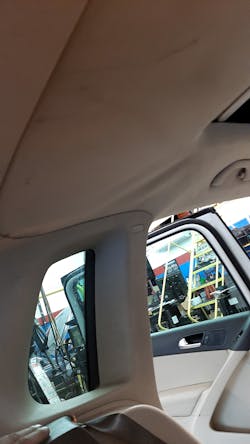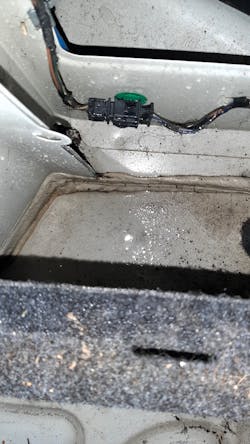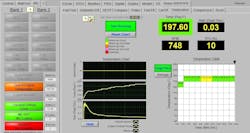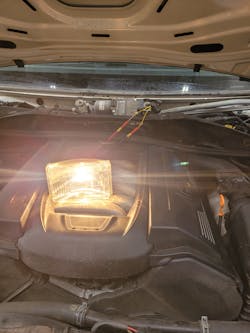The everlasting quest to solving Euro vehicle issues
Content brought to you by Motor Age. To subscribe, click here.
What You Will Learn:
• Having the right tools, the know-how, and adequate service information allows for proper diagnosis and repair
• Fixing the root cause of the problem, and not just the symptom is required to ensure proper repair and prevent comebacks
• Dynamic circuit tests are far superior to static circuit tests
This series of vehicles gave us a run for our money, but it all came together in the end with the correct tools and information in hand.
The running water pump
We had a 2011 BMW X5 35i E70 with 148,312 miles on the odometer. We received the vehicle with a complaint from the vehicle owner that his battery was going dead. At first, he just wanted us to check the battery and replace it, but we explained that the proper way is to diagnose the vehicle for the cause of a parasitic draw.
His description of the battery going dead multiple times indicated that our suggestion would be the diagnostic path to take. The BMW owner listened to our explanation and authorized us to diagnosis the problem. My tech, Franklin was assigned to this vehicle and followed a proper diagnostic game plan. It included the following:
- A visual inspection
- Vehicle DTC / health scan
- Testing of the battery, starter and charging system, followed by RTFI (reading the friggin’ information)
After all the previous tests were performed, the following DTCs were displayed:
- 378F BSD (bit n date) message from the electric coolant pump
- Missing static fault currently missing (Car Access System)
- D904 K‐CAN wiring
- 6EC4 80PP DSC (Dynamic Stability Control) Steering Angle Sensor Adjustment
and about 10 more codes (Figure 1) that had nothing to do with the water pump staying on.
Gaining diagnostic direction
The battery test resulted in a failure, so we recommended replacing it. The starter and charging system test performed as designed, making our next step digging into service information.
In ALLDATA, we found a TSB for the BMW BSD and Local Interconnected Network (LIN) yielding an issue with the water pump as described in the 378F code. The bit-serial data interface is a single-wire data bus that the electric coolant pump communicates on. What else is on this bus?
The following components are connected to the digital motor electronics (DME), or ECU:
- Alternator
- Intelligent battery sensor
- The electric coolant pump
- The oil condition sensor
That information allows us to target our diagnosis on those components that have influence on allowing the water pump to operate. If there is an issue with any of them, that would be the reason the water pump would still operate with the key / fob out of the ignition.
With the information we just reviewed Franklin proceeded to check the BSD system carefully due to the issue of the water pump that was staying on. He figured more heads were better than one and contacted our friend Pierre Respaut, a BMW expert, who advised him to disconnect the battery sensor to see if the water pump would stop running. Since the disconnected battery sensor failed to stop the pump from running, his next step was to disconnect the alternator, and that also made no difference. Franklin lastly disconnected the oil level sensor that also controls the water pump, but that still did not resolve the problem. Pierre, Franklin, and I thought the best thing to do now to protect the new battery (that had already been installed and coded to the DME) from going dead was to disconnect the radiator switch that controls the water pump.
Our next step was to call the BMW owner and recommend a water pump that must have had an internal failure causing this vehicle’s parasitic draw. Franklin explained to the BMW owner that the water pump is a bit different on this engine. He told the owner that the pump is used for heat management that determines the current cooling requirement regulating the cooling system that utilizes the water pump to achieve proper results.
Under conditions where engine cooling is not needed the water pump can even be switched off completely. On a cold engine condition for example where a proper warm up is required to provide even temperature the water pump may not be turned on until a certain engine temperature is achieved. If the engine is not running but the coolant or oil is very hot the water pump will be commanded to operate even with the vehicle locked. This was the problem that killed the battery.
Believe it or not, the vehicle owner decided not to replace the water pump because it was too expensive. We reconnected the radiator switch to prevent the engine from overheating and causing damage, followed by disconnecting the negative terminal to the battery to prevent it from going dead. As of this writing, he has still not returned and must disconnect and connect the battery negative terminal every time he enters or exits the vehicle. You can’t fix stupid, can you?
The locked trunk
Our next vehicle is 2011 BMW 335i Convertible (with 72,629 miles) that came in with a report of no radio and no warning tones (Figure 2). My tech, Bill, first spoke to the vehicle owner then performed a visual inspection, followed by performing a full vehicle scan using the OPUS IVS legacy software. The result of the scan was an amplifier that failed to communicate, and other modules that needed updates (but had nothing to do with the issue on this vehicle) (Figure 3).
As with most Euro vehicles, there are often water intrusion issues associated with electrical problems. This BMW convertible was no exception. As Bill was performing his visual inspection, he noticed the usual clogged drains (Figures 4, 5 + 6). This was the first time this vehicle had been to our shop; otherwise, the drains would have been cleaned. When any vehicle comes in for service or inspection, we make it a habit to remove leaves, pine needles and other debris from the cowl and trunk areas. We use an air vacuum that we have in each bay to remove anything we cannot remove by hand. Bill took pictures to show the vehicle owner the issue and told her she would need to stop by the shop periodically to have us make sure no debris is present.
Since the drains were clogged, our first step was to get them free of debris and properly flowing again. Bill had assigned the job to Mary (our newest tech and former student of mine). Mary lives over four hours away and drives to my shop to work in a professional environment and learn from master techs such as Bill, Franklin, and me. Her job for this BMW was to clean the drains and work on getting the trunk unlocked.
The trunk would not open with the key fob command or the trunk release button ever since the vehicle owner disconnected the battery (while trying to fix this problem). Bill located the wiring diagram in Mitchell ProDemand to see where the wires from the trunk to the switch were located. Bill located the wires under the dash that were buried in the right-side kick panel and discovered that they were connected to a module before going to the switch.
Bill made an executive decision to cut the wires that were connected to the module instead of taking a chance of manually energizing the circuit and damaging it. He located the wires and double checked the wiring diagram before proceeding to cut them. After the wires were cut Bill had Mary supply power and ground to the correct wires that were connected to the trunk latch. The results of her action were the trunk latch now released, allowing access to the trunk area.
Once they were in, Bill proceeded to check the amplifier located on the left side of the trunk (Figure 7). Mary then temporarily connected the cut wires to make sure the trunk would release from the fob command and trunk release button. Since both worked as designed, she proceeded to repair the wires properly with solder and shrink tubing before retesting.
In the meantime, Bill tested the Media Oriented Systems Transporter network (MOST). It is a fiber optic system that transmits light signals for communication between ECUs (Figure 8). Before condemning any part (and in this case the amplifier) just because there is a DTC for the component would be the wrong move to make. Remember that the system needs to be tested first to confirm that the fiber optics are good.
You ask, how do you check the fiber optic system? Well, there are two ways available. One with a fiber optic bypass loop tester (that is an excellent tool for diagnosing and bypassing MOST components). The other way is to use a laser pointer to check if light comes out of the other end of the fiber line, confirming that there is no damage or restriction to the MOST lines.
Bill confirmed that the fiber lines were good using both test methods, leaving the amplifier as the issue. Once again poor maintenance practices were the cause of this BMW problem. We provided pricing to the BMW owner, but she thought it was too expensive and decided to live without a radio and chimes. Let’s see how long that lasts before she needs her music back.
All lit up
The owner of a 2014 Mercedes Benz SL550 (with 34,767 miles) has a complaint that the rear taillights would stay on after the vehicle was parked and locked (Figure 9). Franklin performed a scan of all modules and found no codes related to the rear lights staying illuminated.
After he “RTFI” he discovered what we already knew from our previous experience with these Benz’s, that the signal acquisition module (SAM) had a problem. He asked the owner if the vehicle was involved in an accident or if someone had worked on the vehicle recently, she said neither one was true. The customer also explained that this issue had just started a couple of weeks ago when the lights stayed on and eventually prevented the engine from cranking over.
Franklin checked all voltage and ground feeds, finding them all within specification. That only left the SAM that could cause the problem. We ordered the new SAM and installed it followed by using our Opus IVS.We then contacted their tech support to code the module. Using the Opus IVS tech support saved us time doing it ourselves, allowing us to catch up on other work that we had backed up. Franklin rechecked the vehicle after the module coding was complete and found all DTCs were cleared and everything worked like it should, the Benz was fixed.
The underachiever
The next vehicle was a 2011 VW Tiguan SEL 2.0L Turbo with 132,514 miles, and a list of customer complaints, including oil leaking, low power, engine coolant leaks, water leaks, mildew smell, dimming lights and hard starting.
This vehicle seemed to be a complete mess. The tires were as bald as my head, along with the brakes being down to metal, lights out, axle boot ripped and to make matters worse, water leaks inside the vehicle. I always say the best tools we have are our brain, eyes, ears, nose, and hands; and look at what we seen and felt that led us to locating the problem, a wet headliner (Figure 10). The headliner issue led us to check the moon roof drains, where we located broken drain tubes that were the cause of the big water leak. We followed the water trail to the trunk area, where we found over two inches of water (Figure 11). We had to remove the headliner to get access to the moon roof tubes and replace them with new ones prior to checking the drain system for proper operation.
Once the tubes were draining as designed, we dried everything up and reinstalled the headliner. That fixed the water leak, mildew smell, and some of the lighting issues, but there were more. We tested the battery, starter, and alternator. We found the alternator to be defective; the battery was just low and needed to be charged and retested. The oil, coolant leaks and low power were due to a turbo issue. We replaced the turbocharger after receiving the owner's approval. This resulted in a leak-free engine and the vehicle was now fixed and running like new again.
Inspection failure
This vehicle is a 2005 BMW Z4 2.5L with 128,089 miles on it. It’s having a problem getting a passing grade for New York state emissions inspection. The vehicle’s monitors would not become "ready” after the battery went dead with the vehicle sitting around for a while.
We checked the vehicle by performing a full vehicle scan and found that there were no DTCs and one emissions monitor “not ready.” We switched scan tools to the eScan (from Automotive Test Solutions) because its plotted data is easier to see. Over the years, I noticed that there is a load of issues with the cooling system that prevent the monitor from becoming “ready.” Using the eScan, we can see instantly if there are problems with the cooling system.
If we notice the time to temperature is not in the “green” after the engine is up to operating temperature, we go into Sharpshooter, under the Temperature tab. There, we will check to see what the issue is (Figure 12). The results of the test were that the engine was heating up too fast. This problem can be caused by a thermostat that is out of calibration, coolant issues or a few other problems (even if the engine is not overheating and supplying good heat).
Bill installed an OE thermostat and BMW antifreeze/coolant and made sure the time to temperature was good when he finished. Since the monitor was still “not ready,” he asked the owner if he wanted us to drive the vehicle, or did he want to drive it himself. The vehicle owner chose to drive the vehicle himself after Bill and I explained how to drive the vehicle and making sure not to fill the gas tank more than 75 percent of full.
Well, we should have known that the vehicle owner who loves driving this Z4 like a race car would not stay in the parameters to get the monitors “ready.” We had to print out the drive cycle and tell him to stay under 65 miles per hour. Finally, he paid attention (since his car inspection was going to expire in days). The BMW needed to pass, or he was risking a ticket. The owner followed our driving recommendations, and all the monitors were “ready.” The vehicle now passed New York State emissions inspection. The fix was two parts, one the engine needed a new thermostat and antifreeze/coolant and two it needed to be driven properly.
Wipers won’t work
Our last vehicle was a 2007 VW Tiguan that came in with a complaint about the wiper not always working. We checked the vehicle out and found that the wiper motor was not operating as designed. Before we replaced the wiper motor, we checked the voltage and ground supplies.
We always load the circuit up to mimic the intended load of the wiper motor making sure that voltage and ground is supplied properly (Figure 13). We use a headlight that pulls about five to six amps to make sure the circuit can carry a load. Many techs make a mistake of not testing the circuit dynamically, instead relying on open-circuit testing, which could indicate a false positive. Since we had a circuit that was working properly, we ordered a new wiper motor and installed it. Problem solved!
In the end, the challenge isn't the nightmare-vehicles you must face. It's being sure you understand how the systems function and have the know-how and tooling to diagnose the issues.

